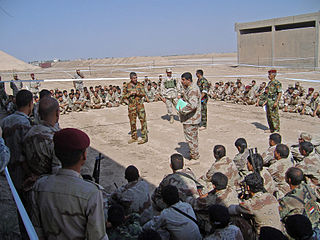
A car bomb, bus bomb, van bomb, lorry bomb, or truck bomb, also known as a vehicle-borne improvised explosive device (VBIED), is an improvised explosive device designed to be detonated in an automobile or other vehicles.

An improvised explosive device (IED) is a bomb constructed and deployed in ways other than in conventional military action. It may be constructed of conventional military explosives, such as an artillery shell, attached to a detonating mechanism. IEDs are commonly used as roadside bombs, or homemade bombs.

After the invasion of Iraq was completed and the regime of Saddam Hussein was toppled in May 2003, the Iraqi insurgency began. The 2003–2006 phase of the Iraqi insurgency lasted until early 2006, when it escalated from an insurgency to a civil war, which became the most violent phase of the Iraq War.

The RPG-29 "Vampir" is a Soviet reusable rocket-propelled grenade (RPG) launcher. Adopted by the Soviet Army in 1989, it was the last RPG to be adopted by the Soviet military before the fall of the Soviet Union in 1991.
Events in the year 2005 in Iraq.

Insurgency weapons and tactics (IWAT) are weapons and tactics, most often involving firearms or explosive devices, intended for use by insurgents to engage in guerrilla warfare against an occupier, or for use by rebels against an established government. One type of insurgency weapon are "homemade" firearms made by non-professionals, such as the Błyskawica (Lightning) submachine gun produced in underground workshops by the Polish resistance movement. Another weapon that is part of the conventional military arsenal, but which has been taken up to great effect by insurgents, is the RPG. Two examples of an improvised weapon used by insurgents would be the improvised explosive devices used in Iraq and the Molotov cocktails used against vehicles and tanks. Two tactics used by many insurgents are assassinations and suicide bomb attacks. The latter tactic is used when an insurgent has a bomb strapped to them or in their car, which provides a low-tech way for insurgents to get explosives close to critical enemy targets.

The Battle of Abu Ghraib was a battle between Iraqi Mujahideen and United States forces at Abu Ghraib prison on April 2, 2005.
Soldiers from the U.S. 1st Armored Division's 3rd Brigade Combat Team struck at insurgent elements in the Al Mansor district on the west side of Baghdad on 7 December 2003, according to U.S. Central Command officials.
The tactics of the Iraqi insurgency have varied widely. Insurgents have targeted U.S. forces and Iraqi government forces using improvised explosive devices, ambushes, snipers, and mortar and rocket fire, in addition to using car bombs, kidnappings or hostage-taking, and assassinations.

Operation Commando Eagle was a 2007 military operation of the Iraq War. It began on 21 June 2007, when Iraqi and Coalition forces launched a combined ground and air assault operation against al-Qaeda and other extremist terrorists operating in the Mahmudiyah region of Babil province. The action was intended to curb terrorist activity southwest of Baghdad through a mix of helicopter assaults and Humvee-mounted movements.
The Ramadan Offensive was a series of insurgent attacks against coalition and Iraqi military targets from the end of October and during much of November 2003.
Operation Phantom Phoenix was a major nationwide offensive launched by the Multinational Force Iraq (MNF-I) on 8 January 2008 in an attempt to build on the success of the two previous corps-level operations, Operation Phantom Thunder and Operation Phantom Strike and further reduce violence and secure Iraq's population, particularly in the capital Baghdad. The offensive consisted of a number of joint Coalition and Iraqi Army operations throughout northern Iraq as well as in the southern Baghdad Belts.

Kata'ib Hezbollah —or the Hezbollah Brigades—is a radical Iraqi Shiite paramilitary group which is part of the Popular Mobilization Forces backed by Iran. During the Iraq War (2003–11), the group fought against Coalition forces. It has been active in the War in Iraq (2013–2017) and the Syrian civil war (2011–present). The group was commanded by Abu Mahdi al-Muhandis until he was killed in a US drone attack in 2020. Thereafter, he was replaced by Abdul Aziz al-Muhammadawi, as the new leader of the Popular Mobilization Forces (PMF). The KH militia seeks to establish an Iran-aligned government in Iraq, expel American forces from the country, and advance the regional and international interests of Iran in Iraq and the region. It takes a central part in carrying out attacks against U.S. targets in Iraq and acts as part of the Axis of Resistance. Kata'ib Hezbollah is directly subordinate to IRGC's Quds Force and operates under its instructions and guidance.
Animal-borne bomb attacks are the use of animals as delivery systems for explosives. The explosives are strapped to a pack animal such as a horse, mule or donkey. The pack animal may be set off in a crowd.

A barrel bomb is an improvised unguided bomb, sometimes described as a flying IED. They are typically made from a large barrel-shaped metal container that has been filled with high explosives, possibly shrapnel, oil or chemicals as well, and then dropped from a helicopter or aeroplane. Due to the large amount of explosives, their poor accuracy, and indiscriminate use in populated civilian areas, the resulting detonations have been devastating. Critics have characterised them as weapons of terror and illegal under international conventions.
The following lists events the happened in 2013 in Iraq.
Improvised artillery in the Syrian Civil War are improvised firearms created and used by factions of the Syrian Civil War, most notably Syrian opposition forces. The weapons include the Hell-Cannon and its variants, the Thunder Cannon and the Mortar Cannon. The weapons have been criticized for being inaccurate.
On 14 September 2017, several members of ISIL staged multiple attacks on the outskirts of Nasiriyah in the southern Dhi Qar Governorate, Iraq, killing at least 84 people and injuring 93 others.

Ashab al-Kahf is an Iraqi Shia militant group that has been described as a proxy formation of Iran. The group first emerged in August 2019, but increased in activity following the American assassination of Qasem Soleimani. It has attacked targets associated with the United States using rockets and improvised explosive devices. The group denies maintaining relationships with other Iranian-backed Shia paramilitary groups, such as Kata'ib Hezbollah and Asa'ib Ahl al-Haq.











